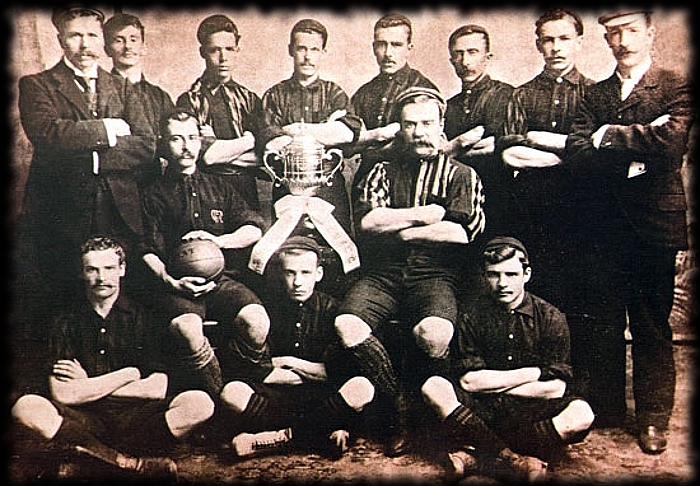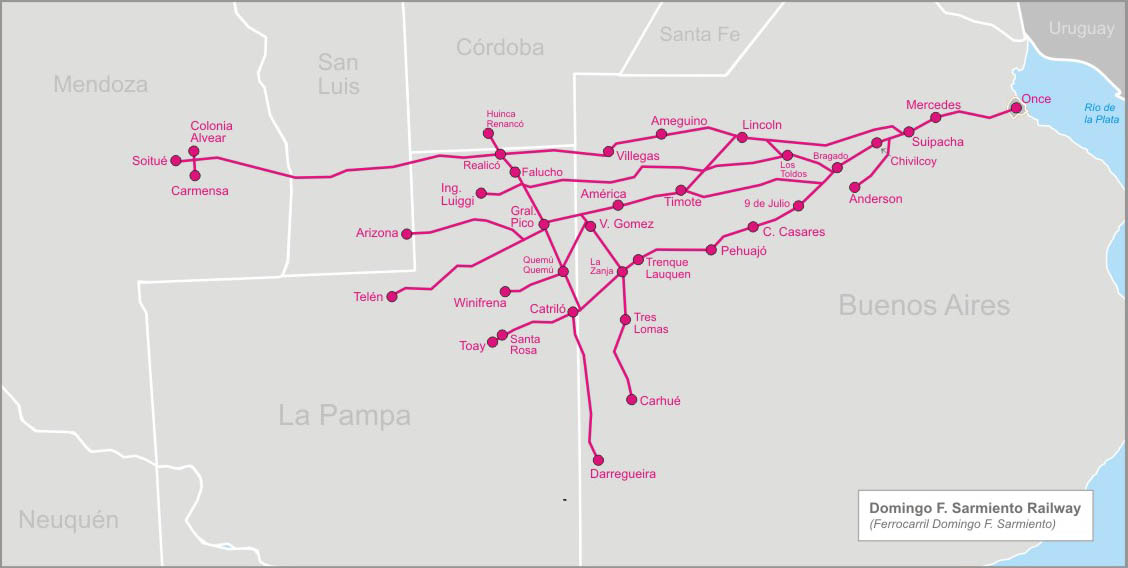|
Estadio Arquitecto Ricardo Etcheverry
Estadio Arquitecto Ricardo Etcheverri, formerly known as Estadio Ferro Carril Oeste, is a stadium located in the Caballito district of Buenos Aires. It is the home venue of Club Ferro Carril Oeste. The stadium, opened in 1905 and located close to Caballito station of Sarmiento Line, has a current capacity of 24,442. Inaugurated on 2 January 1905, Ferro Carril Oeste is the oldest football stadium of Argentina (referring to clubs affiliated to AFA) and the second in South America after Estadio Gran Parque Central (home venue of Uruguayan Club Nacional de Football, built in 1900). Because of being located near the geographic centre of Buenos Aires, several former clubs used it as their home venues. Some of them were Alumni, Barracas AC, San Lorenzo, Argentinos Juniors, among others. The stadium also hosted test matches played by the Argentina national rugby union team (''Los Pumas'') during the 1970s to early 2000s, where Argentina played Ireland, New Zealand, France and Australia ... [...More Info...] [...Related Items...] OR: [Wikipedia] [Google] [Baidu] |
Caballito, Buenos Aires
Caballito (; Spanish for "little horse") is a '' barrio'' (neighborhood) of the Argentine capital, Buenos Aires. It is the only ''barrio'' in the administrative division ''Comuna'' 6. It is located in the geographical centre of the city, limited by the following streets and avenues: Rio de Janeiro, Av. Rivadavia, Av. La Plata, Av. Directorio, Curapaligüe, Av. Donato Álvarez, Av. Juan B. Justo, Av. San Martín, and Av. Ángel Gallardo. The name is said to come from the horse-shaped (Spanish ''caballo'') weather vane from a local ''pulpería'' (gauchos' bar); ''Caballito'' meaning "Little horse". Places of interest In Caballito there are numerous points of interest; the "English District" with British style "Fin de Siècle" architecture, the Ferro Carril Oeste football Club (or "Verdolaga"), the "Historical Tramway museum of Buenos Aires", the old "Mercado del Progreso" (Market of Progress) a neighborhood favorite since 1890, the Italian Club and the Portuguese Club. Among ... [...More Info...] [...Related Items...] OR: [Wikipedia] [Google] [Baidu] |
Ireland National Rugby Union Team
The Ireland national rugby union team is the men's representative national team for the island of Ireland in rugby union. The team represents both the Republic of Ireland and Northern Ireland. Ireland competes in the annual Six Nations Championship and in the Rugby World Cup. Ireland is one of the four unions that make up the British & Irish Lions – players eligible to play for Ireland are also eligible for the Lions. The Ireland national team dates to 1875, when it played its first international match against England. Ireland reached number 1 in the World Rugby Rankings for the first time in 2019. Eleven former Ireland players have been inducted into the World Rugby Hall of Fame. History Early years: 1875–1900 Dublin University was the first organised rugby football club in Ireland, having been founded in 1854. The club was organised by students who had learnt the game while at public schools in Great Britain. During the third quarter of the nineteenth century, and fo ... [...More Info...] [...Related Items...] OR: [Wikipedia] [Google] [Baidu] |
Flores Athletic Club
Flores Athletic Club was an Argentine sports club from Flores, Buenos Aires. The club was pioneer in the practise of some sports that would become popular in Argentina, such as football (competing in some of the first official championships held), cricket, rugby union, polo, and tennis. History Origin: the polo years In 1860 a great English community lived in the "porteños" neighbourhoods of Caballito and Flores, most of them working in commerce activities. They usually spent summertime in their country houses located in Barracas, Buenos Aires, Belgrano, Buenos Aires and Flores, which was the favourite place of Argentine high society families to spend their free time. Some of the biggest palaces (such as "Miraflores", built in 1886 and currently a school, or "Las Lilas") had been erected in that zone.''Una investigación sobre la Historia del Flores Athletic Club'' by Rubén Ayala at the C.E.H.R., Buenos Aires (1997) The Flores Athletic Club was born in Caballito neighbourhood, ... [...More Info...] [...Related Items...] OR: [Wikipedia] [Google] [Baidu] |
Argentine Primera División
The Primera División (; en, "First Division"), known officialy as Liga Profesional de Fútbol, or Torneo Binance for sponsorship reasons, is a professional football league in Argentina, organised by the Argentine Football Association (AFA). The Primera División is the country's premier football division and is the top division of the Argentine football league system. It operates on a system of promotion and relegation with the Primera Nacional (Second Division), with the teams placed lowest at the end of the season being relegated. Since 2020, relegation has been suspended due to COVID-19 pandemic. With the first championship held in 1891,''Historia del Fútbol Amateur en la Argentina'', by Jorge Iwanczuk. Published by Autores Editores (1992) - Argentina became the first country outside the United Kingdom (where the Football League had debuted in 1888, and the Scottish and Irish Football Leagues in 1890) to establish a football league. In the early years, only teams from ... [...More Info...] [...Related Items...] OR: [Wikipedia] [Google] [Baidu] |
Primera B Metropolitana
Primera B Metropolitana is one of two professional leagues that form the third level of the Argentine football league system. The division is made up of 17 clubs mainly from the city of Buenos Aires and its metropolitan area, Greater Buenos Aires. Originally created as the second division, it became the third level after a restructuring of the system in 1985 that ended with the creation of Primera B Nacional, set as the second division since then. The other league at level three is the Torneo Federal A, where teams from regional leagues take part. Format Primera B Metropolitana is currently organized so, during the course of a season, each club plays the others twice (a double round robin system), once at their home stadium and once at that of their opponents. The team that gets the most points at the end of the season is recognized as the Primera B champion and is automatically promoted to Primera B Nacional. The teams that hold the second to fifth positions have the chance to ... [...More Info...] [...Related Items...] OR: [Wikipedia] [Google] [Baidu] |
Bristol Football Club
Bristol Football Club was a Uruguayan football club, located in Montevideo, that played in the Primera División during the first decades of the 20th. century. The club, founded in 1904, developed a rivalry with Club Nacional de Football, but lost relevance until it was dissolved in 1915. History The club took its name from the homonymous city in England, sharing name with two British clubs, Bristol City F.C. and Bristol Rovers F.C. Bristol F.C. was regarded as an elitist club due to the institution was composed by members of the high society. Moreover, club executives always expressed their strong opposition to bring professionalism to football, mainly to avoid the addition of working classes to Bristol. In 1911, a group of footballers of Nacional that had left the club in disagreement with changes carried out by the committee lead by president José María Delgado, joined Bristol F.C. Some of them were Jorge Pacheco, Juan Pena, Luis Carbone, Alberto Century (topscorer in 1 ... [...More Info...] [...Related Items...] OR: [Wikipedia] [Google] [Baidu] |
1914 Tie Cup Final
The 1914 Tie Cup Final was the final match to decide the winner of the Tie Cup, the 4th. edition of the international competition organised by Argentine and Uruguayan Associations together. As its previous editions, the final was contested by Argentine club River Plate (champion of 1914 Copa de Competencia Jockey Club) and Uruguayan club Bristol F.C. in replacement of Nacional (1914 Uruguayan Copa de Competencia champion), as runner-up. The match, held in Ferro Carril Oeste Stadium, was won by River Plate 1–0 with goal by Juan Gianetto. With this achievement, River Plate won its first international title. Qualified teams ;Notes: Overview River Plate had earned to play the final after winning the 1914 Copa de Competencia Jockey Club (which was also its first official title in the top division of Argentine football) after beating Newell's Old Boys 4–0 in the final played at Estadio Racing Club in Avellaneda. [...More Info...] [...Related Items...] OR: [Wikipedia] [Google] [Baidu] |
Central Uruguay Railway Cricket Club
Central Uruguay Railway Cricket Club (mostly known for its acronym CURCC) was a Uruguayan sports club, originally established by British railway workers for the practise of cricket. Nevertheless, the club would be notable for its football section, considered one of the greatest contributors to that sport in Uruguay. In fact, CURCC was one of founding members of Uruguayan Football Association (AUF) in 1900.Historia de la Asociación on AUF website The continuity between the CURCC's football section and club generated a controversy that remains nowadays."C.U.R.C.C. versus Club A. Patria", chronicle on ''La Razón'', 23 Jul 1914 (page 6) History Railway ...
|
Estadio Ferro 1940
A stadium ( : stadiums or stadia) is a place or venue for (mostly) outdoor sports, concerts, or other events and consists of a field or stage either partly or completely surrounded by a tiered structure designed to allow spectators to stand or sit and view the event. Pausanias noted that for about half a century the only event at the ancient Greek Olympic festival was the race that comprised one length of the stadion at Olympia, where the word "stadium" originated. Most of the stadiums with a capacity of at least 10,000 are used for association football. Other popular stadium sports include gridiron football, baseball, cricket, the various codes of rugby, field lacrosse, bandy, and bullfighting. Many large sports venues are also used for concerts. Etymology "Stadium" is the Latin form of the Greek word " stadion" (''στάδιον''), a measure of length equalling the length of 600 human feet. As feet are of variable length the exact length of a stadion depends on the exac ... [...More Info...] [...Related Items...] OR: [Wikipedia] [Google] [Baidu] |
Club Atlético River Plate
Club Atlético River Plate, commonly known as River Plate, is an Argentine professional sports club based in the Núñez, Buenos Aires, Núñez neighborhood of Buenos Aires. Founded in 1901, the club is named after the English name for the city's estuary, Río de la Plata. Although many sports are practiced at the club, River Plate is best known for its professional association football, football team, which has won Argentina's Argentine Primera División, Primera División championship a record of 37 times, its latest title in 2021 Argentine Primera División, 2021. Domestic achievements also include 14 List of Argentine football national cups, national cups, with the 2021 Trofeo de Campeones de la Liga Profesional, 2021 Trofeo de Campeones as the most recent, making River Plate the country's most successful team in domestic competitions with a total of 51 top-division titles. [...More Info...] [...Related Items...] OR: [Wikipedia] [Google] [Baidu] |
Buenos Aires Western Railway
The Buenos Aires Western Railway (BAWR) (in Spanish: Ferrocarril Oeste de Buenos Aires), inaugurated in the city of Buenos Aires on 29 August 1857, was the first railway built in Argentina and the start of the extensive rail network which was developed over the following years. The locomotive ''La Porteña'', built by the British firm EB Wilson & Company in Leeds, was the first train to travel on this line. The route initially measured , stretching from Del Parque station (now the site of the Teatro Colón) to Floresta station, which at that time was located in San José de Flores village, but is now within Buenos Aires city limits. The rails were laid along what are now Lavalle, Enrique S. Discépolo, Avenida Corrientes and Avenida Pueyrredón, and then followed the route of the current Domingo Sarmiento Railway line towards Floresta. Although the construction of this line was proposed by a group of private individuals known as the "Sociedad del Camino-Ferrocarril al Oest ... [...More Info...] [...Related Items...] OR: [Wikipedia] [Google] [Baidu] |









